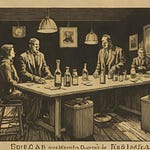Hi All!
Thanks for subscribing to The Science of Alcohol Testing.
Yesterday, I spoke with Dr. Joseph Anderson about how breath alcohol testing actually works.
Dr. Joseph Anderson is the owner of Anderson Bioscience, a biotechnology consulting company, and an Affiliate Assistant Professor of Bioengineering at the University of Washington. He has a PhD in chemical engineering and has published over 50 peer-reviewed publications and three book chapters.
Dr. Anderson explains that for too long, it has been assumed that breath alcohol testing measures the alcohol exchange taking place in the alveolus (aka deep lung air). But he says that the majority of the gas exchange takes place in the airways and membranes leading to the lungs.
We discuss the implications of the new paradigm and what it means for breath alcohol testing. For one, it biases those with smaller lungs; and two it means that those who blow more volume than average will have a higher breath alcohol concentration than those who stop after the minimums sample parameters have been achieved.
Topics we cover:
Research concerning gas exchange in the lungs
Gas exchange in the lung: Old vs. New Paradigm
Old paradigm: All gases exchange in alveoli
The location of gas exchange in the lungs depends on solubility in the blood
New paradigm: High blood soluble gases (alcohol) exchange in airways
The consequence of the new paradigm:
Exhaled air volume affects breath alcohol concentration
Acetone exchange in the lung
Endogenous production resulting from fat metabolism
Indicator of fat metabolism
Breath acetone measurement
Elevated in diabetes and greatly elevated in uncontrolled diabetes
Interfering substances: Acetone and isopropanol












